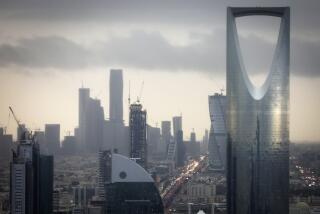Power Plant Shines Light on High Hopes, Setbacks
- Share via
BAGHDAD — The gleaming silver spires and wires of the Al Quds power station just outside Baghdad represent what U.S. officials point to as Iraq’s future.
The station has been the focus of an intense rehabilitation and expansion project -- including the construction of an additional six turbines that, when completed, will add 422 megawatts of power to Iraq’s overburdened electrical grid.
Every extra megawatt is badly needed. The United Nations has estimated that daily production capacity had dwindled to 4,400 megawatts in the final year of Saddam Hussein’s regime. After the U.S. invasion of Iraq, sabotage has wreaked havoc on the power grid. Although many Baghdad residents say they haven’t noticed much improvement, Coalition Provisional Authority officials said this month that the national power supply had improved by as much as 10% from the Hussein era.
But a visit to the station also shines a light on the miscommunication and lack of follow-up that have hampered coalition efforts to rebuild Iraq’s battered infrastructure. According to engineers at the plant, millions in U.S. development dollars were spent to convert the two original turbines to burn crude oil in addition to diesel fuel.
The conversion would have improved fuel economy and enabled the plant to use oil pumped from a neighboring refinery. But the plan faltered almost immediately, the facility’s staff said, thwarted by a lack of spare parts and maintenance. Despite the rehabilitation, the turbines continue to burn diesel.
U.S. officials defend the investment and say everything has worked fine. Officials acknowledge, however, that they’re scrambling to meet demand. In the post-Hussein era, consumers are rushing to buy satellite dishes and home appliances.
“We’re chasing a target that’s always a little faster than us,” said a CPA power sector official.
The Quds project is meant to be a major factor in filling that demand. The station, built in 2001, was in relatively good shape after last year’s war to oust Hussein’s government.
The U.S. Agency for International Development spent $3 million to refurbish the two existing 125-megawatt turbines, and the Army Corps of Engineers is overseeing the construction of the six new turbines. The first of those new generators, which is expected to start producing power in a few weeks, was the subject of a ribbon-cutting ceremony Saturday attended by interim Prime Minister Iyad Allawi and Electricity Minister Ayham Sameraei.
“This is a gift from the American people to the Iraqi people,” Allawi said. “It’s an important step in the reconstruction of Iraq.” The other five new turbines are scheduled to come online by the end of August.
But the original two turbines and their USAID-funded conversion remain a subject of confusion. Plant engineers told reporters Saturday that the expensive refitting to equip the turbines for crude oil never really came to fruition. Crude oil is cheaper and more plentiful than diesel fuel -- and easily accessible via pipeline from the nearby refinery. But the engineers said that crude oil required greater maintenance and a steady replacement of parts.
Those spare parts are in short supply, and the responsibility for providing them has apparently fallen into the gap between USAID and the soon-to-be-sovereign Electricity Ministry.
USAID officials maintained that the turbines had been ready to burn crude since February but said diesel fuel was being used during the summer months because it produced more power. “We need every megawatt we can get to meet the demand,” a USAID spokeswoman said. “In the autumn, it’s more logical to turn to crude.”
But plant workers said it was doubtful the plant would shift to crude oil as long as the spare parts for the turbines were in short supply.
“We did our end of the deal,” said the USAID spokeswoman, who said a USAID engineer remained on site at the plant to monitor the two original turbines. “We didn’t just do the work and leave them behind.”
Meanwhile, plant and ministry officials offered conflicting versions of just when the turbines might be able to make use of the plentiful supply of crude.
Sameraei, the Electricity minister, shrugged off questions about the spare parts, saying, “I expect within three to six months to have many of these problems ironed out.”
Waleed Salman, the plant manager, offered a more optimistic assessment, estimating that the plant could begin burning crude within three days. But, he added, a “special situation” made it preferable to use diesel.
“It’s very technical,” he said. “I couldn’t explain it to you.”
More to Read
Sign up for Essential California
The most important California stories and recommendations in your inbox every morning.
You may occasionally receive promotional content from the Los Angeles Times.













